Colombia – Medellín
Art at its Best
Medellín galt als «Welthauptstadt des Kokains» und als die gefährlichste Stadt der Welt. Noch immer werden Morde begangen, doch statt mächtiger Drogenkartelle beherrschen heute Hunderte kleinerer krimineller Banden die Slums. In den letzten Jahren hat sich Medellín zu einer der innovativsten Städte des Landes und zu einer Hochburg der kolumbianischen Kunst und Kultur entwickelt. Das MAMM Museo de Arte Moderno de Medellín wurde 1980 von zwanzig Künstlern gegründet. Im Jahr 2006 zog das Kunsthaus an seinen heutigen Standort, das Gebäude Talleres Robledo im Stadtteil Ciudad del Rio. In diesem avantgardistischen Komplex stellen zeitgenössische kolumbianische Künstler ihre Werke aus. Das Museum, der Buchladen, das Café und die umliegenden Restaurants sind zu einem beliebten Treffpunkt für Besucher aus der Region und Kunstliebhaber aus aller Welt geworden.

Medellín was considered the «world capital of cocaine» and the most dangerous city in the world. Murders are still committed, but instead of powerful drug cartels, hundreds of smaller criminal gangs now dominate the slums. In recent years, Medellín has become one of the most innovative cities in the country and a stronghold of Colombian art and culture. The MAMM Museo de Arte Moderno de Medellín was founded in 1980 by twenty artists. In 2006, the art house moved to its current location, the Talleres Robledo building in the Ciudad del Rio neighborhood. Contemporary Colombian artists exhibit their works in this avant-garde complex. The museum, bookstore, café and surrounding restaurants have become a popular meeting place for visitors from the region and art lovers from around the world.

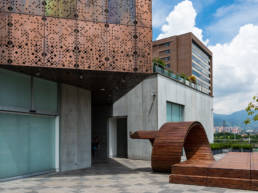

Medellín was considered the «world capital of cocaine» and the most dangerous city in the world. Murders are still committed, but instead of powerful drug cartels, hundreds of smaller criminal gangs now dominate the slums. In recent years, Medellín has become one of the most innovative cities in the country and a stronghold of Colombian art and culture. The MAMM Museo de Arte Moderno de Medellín was founded in 1980 by twenty artists. In 2006, the art house moved to its current location, the Talleres Robledo building in the Ciudad del Rio neighborhood. Contemporary Colombian artists exhibit their works in this avant-garde complex. The museum, bookstore, café and surrounding restaurants have become a popular meeting place for visitors from the region and art lovers from around the world.
Colombia – Getsemaní
Graffiti gegen Armut

Getsemaní was once a place of prostitution and drug dealing. Graffiti turned the neighborhood into a gallery for street art. Local artists recognized the opportunity to reclaim the streets with their spray cans and imagination. Their artworks tell stories of local legends that they honor and are part of Getsemaní’s living heritage. Arguably, some of the most spectacular works are located in the narrow streets around Plaza de la Trinidad. The Afro-Colombian woman of DEXS is one of the most photographed graffiti in Getsemaní. The group of young people around DjLu is particularly impressive. Even world stars like Puerto Rican megastar Ricky Martin and Colombian singer Juanes use Getsemaní as a backdrop for their music videos.


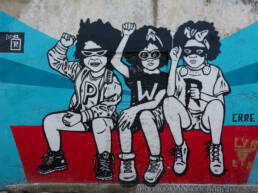
Land im Aufbruch
Kolumbien versprüht karibisches Flair. Die Herzlichkeit und Lebensfreude der Menschen verdrängt die Schatten der Vergangenheit.
Colombia exudes Caribbean flair. The warmth and exuberant joie de vivre of the people displace the shadows of the past.
Colombia – Getsemaní
Graffiti gegen Armut
Getsemaní war einst ein Ort der Prostitution und des Drogenhandels. Graffiti verwandelten das Viertel in eine Galerie für Strassenkunst. Lokale Künstler schufen die ersten Wandbilder in der Calle de la Sierpe an einer tristen Betonwand, die als öffentliche Toilette diente. Sie erkannten die Gelegenheit, mit ihren Sprühdosen und ihrer Fantasie die Strassen zurückzuerobern. Ihre Kunstwerke erzählen Geschichten von lokalen Legenden, die sie ehren und die Teil des lebendigen Erbes von Getsemaní sind. Einige der spektakulärsten Werke befinden sich in den engen Strassen um die Plaza de la Trinidad. Die afrokolumbianische Frau von DEXS ist eines der meistfotografierten Graffiti in Getsemaní. Besonders beeindruckend ist die Gruppe junger Leute um DjLu. Selbst Weltstars wie der puertoricanische Megastar Ricky Martin und der kolumbianische Sänger Juanes nutzen Getsemaní als Kulisse für ihre Musikvideos.



Getsemaní was once a place of prostitution and drug dealing. Graffiti turned the neighborhood into a gallery for street art. Local artists created the first murals on Calle de la Sierpe on a drab concrete wall that served as a public restroom. They recognized the opportunity to reclaim the streets with their spray cans and imagination. Their artworks tell stories of local legends that they honor and are part of Getsemaní’s living heritage. Arguably, some of the most spectacular works are located in the narrow streets around Plaza de la Trinidad. The Afro-Colombian woman of DEXS is one of the most photographed graffiti in Getsemaní. The group of young people around DjLu is particularly impressive. Even world stars like Puerto Rican megastar Ricky Martin and Colombian singer Juanes use Getsemaní as a backdrop for their music videos.

Land im Aufbruch
Kolumbien versprüht karibisches Flair. Die Herzlichkeit und Lebensfreude der Menschen verdrängt die Schatten der Vergangenheit.
Colombia exudes Caribbean flair. The warmth and exuberant joie de vivre of the people displace the shadows of the past.
Colombia – Medellín
Boteros Geschenk


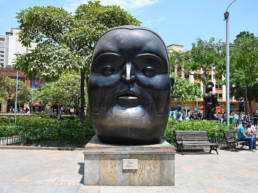
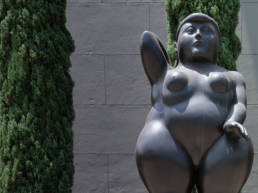
Fernando Botero – the most famous South American artist of the present day – has donated twenty-three bronze sculptures to his hometown of Medellín. They stand in Plaza Botero, in the heart of the city. Botero was born in 1932 and grew up in modest circumstances. The visual arts fascinate the youngster. He goes to Bogotá, where he finds a connection to the artistic avant-garde. His first stay in Europe from 1952 to 1955 influences his artistic development. His signature style, Boterismo, emerges in 1956 with the still life of a mandolin. In addition to painting, Botero began creating sculptural works in the 1960s. His Abu Ghraib series is to be understood as political and social criticism. The torture by American troops in a prison during the Iraq War shocked him. He expressed his anger at the events in fifty paintings. They depict typically voluptuous characters as hooded, naked Iraqi prisoners. His depictions are unsparing.
Colombia – Isla Fuerte
Inselparadies

Isla Fuerte is an insider tip among divers. About two thousand people live year-round on the 325-hectare island. During the high season in January and at Easter, the Colombians conquer the sandy beaches. Narrow paths crisscross the island, which can be explored on foot in five to six hours. The lush vegetation of the tropical dry forests and mangroves is home to up to eighty species of birds and smaller mammals. The star among them is the cute three-fingered sloth, which makes its home high up in the treetops. Another attraction is the ancient banyan tree, which the islanders call «el árbol que camina,» meaning «wandering tree.» The main attractions of the island are its secluded beaches, crystal clear waters and Caribbean idyll.


Islands & Beaches
Die unberührte Inseln, raue Küstenabschnitte und lusche Regenwälder gehören zum Schönsten, was Kolumbien zu bieten hat.
The pristine islands and rugged coastlines and lush rainforests are some of the most beautiful things Colombia has to offer.
Colombia – Tyrona Nationalpark
The great Escape
In der Vergangenheit war Tayrona Rebellengebiet und ein Stützpunkt für den Drogenschmuggel. Heute ist der 1969 gegründete Nationalpark ein touristischer Hotspot. In der Hochsaison wird er von Touristen überschwemmt. Deshalb ist die tägliche Besucherzahl auf 1500 begrenzt. Das Besucherzentrum befindet sich an der Küstenstrasse, dreissig Kilometer nördlich von Santa Marta. Zu Fuss oder auf dem Rücken eines Pferdes führt ein Dschungelpfad zum Strand von Arrecifes. Der Weg schlängelt sich durch den Regenwald über wackelige Holzbrücken und glitschige Steintreppen zu einem Aussichtspunkt. Nach einem steilen Abstieg ist man schliesslich am Ziel — am Strand von El Cabo San Juan del Guía. Ohne Übernachtung ist die Wanderung eine schöne, wenngleich anstrengende Tagestour.

In the past, Tayrona was rebel territory and a base for drug smuggling. Today, the national park, founded in 1969, is a tourist hotspot. In the high season it is flooded with tourists. Therefore, the daily number of visitors is limited to 1500. The visitor center is located on the coastal road, thirty kilometers north of Santa Marta. On foot or on horseback, a jungle trail leads to Arrecifes beach. The path winds through the rainforest over rickety wooden bridges and slippery stone stairs to a viewpoint. After a steep descent, you finally reach your destination – the beach of El Cabo San Juan del Guía. Without an overnight stay, the hike is a beautiful, albeit strenuous, day trip


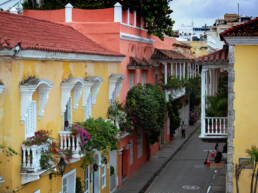
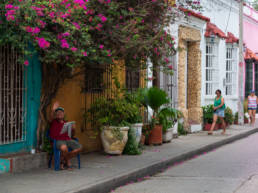
Cartagena is the most beautiful city in Colombia. The magnificent old town captivates everyone. It’s is easy to stroll and indulge in idleness. The cobbled streets are lined with magnificent houses whose patina glows in turquoise, mustard yellow and pink.
Colombia – Cartagena
Die Perle der Karibik
Cartagena ist die schönste Stadt Kolumbiens. Die prächtige Altstadt zieht jeden in ihren Bann. In der kolonialen Altstadt Cartagenas lässt es sich leichtfüssig schlendern und dem Müssiggang frönen. Die gepflasterten Gassen sind von prachtvollen Häusern gesäumt, deren Patina in Türkis, Senfgelb und Rosa leuchtet.
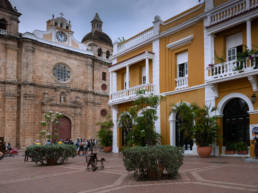
In Gabos Fussstapfen
Colombia – Cartagena
Die Perle der Karibik
Cartagena ist die schönste Stadt Kolumbiens. Die prächtige Altstadt zieht jeden in ihren Bann. In der kolonialen Altstadt Cartagenas lässt es sich leichtfüssig schlendern und dem Müssiggang frönen. Die gepflasterten Gassen sind von prachtvollen Häusern gesäumt, deren Patina in Türkis, Senfgelb und Rosa leuchtet.

Cartagena is the most beautiful city in Colombia. The magnificent old town captivates everyone. It’s is easy to stroll and indulge in idleness. The cobbled streets are lined with magnificent houses whose patina glows in turquoise, mustard yellow and pink.


In Gabos Fussstapfen
Kaum eine Stadt war für den Schriftsteller Gabriel García Márquez wichtiger als Cartagena. Hier hat der Literaturnobelpreisträger studiert und angefangen zu schreiben. Obwohl er die Stadt in keinem seiner Werke namentlich erwähnte, lassen die Beschreibungen und Ortsnamen den Schluss zu, dass er von ihr inspiriert wurde.
Few cities were more important to the writer Gabriel García Márquez than Cartagena. The beautiful colonial town is where the winner of the Nobel Prize for Literature studied and began writing. Although he did not mention the city by name in any of his works, the descriptions and place names suggest that he was inspired by it.
Colombia – Bogota
Mega City

Bogotá is a subject of controversy. Most tourists stay only for one night. They visit the Gold Museum, enjoy the view from the top of Cerro de Monserrate, and then move on briskly. But Bogotá offers more: galleries celebrating local artists, a vibrant restaurant scene and up-and-coming neighborhoods with a better-than-average quality of life.
Rundgang
Bogotá ist kein koloniales Juwel wie Cartagena. Dennoch lieben die Bogotanos ihre Stadt. Nach über fünfzig Jahren Bürgerkrieg hat sich Kolumbiens Hauptstadt zu einer modernen Metropole entwickelt.
Bogotá is not a colonial jewel like Cartagena. Nevertheless, Bogotanos love their city. After more than fifty years of civil war, Colombia’s capital has become a modern metropolis.
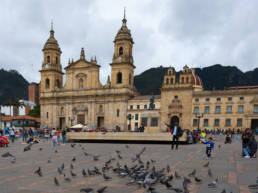

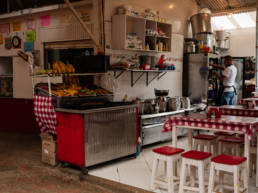
Colombia – Bogotá
Mega City
An Bogotá scheiden sich die Geister. Die meisten Besucher lassen die Neun-Millionen-Metropole aussen vor. Und machen damit einen Fehler. Armut, Verkehr, Kriminalität und ausgiebig Regen: Bogotá bedeutet selten Liebe auf den ersten Blick. Die meisten Touristen bleiben nur für eine Nacht. Sie besuchen das Goldmuseum, geniessen die Aussicht vom Gipfel des Cerro de Monserrate, und fahren dann zügig weiter. Doch Bogotá bietet mehr: Galerien, die lokale Künstler feiern, eine junge Gastroszene und aufstrebende Quartiere mit einer überdurchschnittlich hohen Lebensqualität.

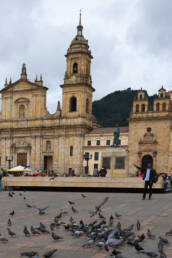

Bogotá is a subject of controversy. Most tourists stay only for one night. They visit the Gold Museum, enjoy the view from the top of Cerro de Monserrate, and then move on briskly. But Bogotá offers more: galleries celebrating local artists, a vibrant restaurant scene and up-and-coming neighborhoods with a better-than-average quality of life.

Rundgang
Bogotá ist kein koloniales Juwel wie Cartagena. Dennoch lieben die Bogotanos ihre Stadt. Nach über fünfzig Jahren Bürgerkrieg hat sich Kolumbiens Hauptstadt zu einer modernen Metropole entwickelt.
Bogotá is not a colonial jewel like Cartagena. Nevertheless, Bogotanos love their city. After more than fifty years of civil war, Colombia’s capital has become a modern metropolis.
